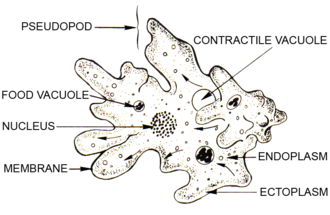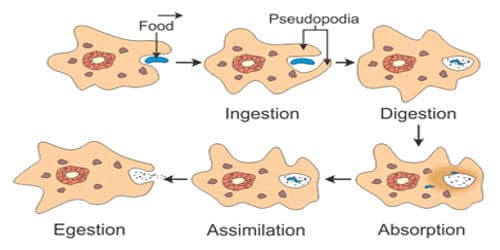Holozoic nutrition refers to a form of heterotrophic nutrition where an organism consumes complex organic food materials by ingesting them, followed by digestion and absorption of the nutrients into its body cells.
The term Holozoic comes from the Greek word: holo-whole; zoikos-of animals.
Index
Explanation
This nutrition involves obtaining energy and organic components by consuming and digesting other organisms or parts of organisms, such as decaying organic matter and blood.
This type of nutrition is exhibited by a variety of organisms, including protozoa like amoebas and most free-living animals, such as humans.
And the act of consuming a substance by an organism is called ingestion. In animals, this process typically involves taking in a substance through the mouth and into the gastrointestinal tract, which occurs when they eat or drink.
In single-celled organisms, ingestion occurs through the absorption of a substance through the cell membrane.
During holozoic nutrition, food is taken into the organism’s body as solid or liquid, and then further broken down for absorption.
It is the most common type of nutrition observed in the animal kingdom.
This differs from holophytic nutrition, where photosynthesis or chemosynthesis is used to obtain energy and organic building blocks.
It differs from saprozoic nutrition, where digestive enzymes are released externally and monomers are absorbed directly from the environment.

Steps Involved
- Ingestion: It refers to the intake of food materials, typically through the mouth, in the case of holozoic nutrition.
- Digestion: It is the process by which large organic molecules from the diet are broken down into simpler, absorbable forms.
- Absorption: It involves the uptake of the digested nutrients through various methods, which can then be used for further utilization.
- Assimilation: It is the process of utilizing the absorbed food to meet the energy requirements of the body, allowing for the performance of all metabolic functions.
- Egestion: It refers to the removal of excretory waste materials such as feces and urine from the body, completing the digestive process.

Types of Holozoic Organisms
Holozoic organisms can be divided into three types based on their feeding habits.
- Herbivores: They are animals that rely on plants as their primary source of food and nutrition.
Examples of herbivores include deer, elephants, goats and cows.
- Carnivores: They are the animals that feed on other animals for their source of food.
Examples of carnivores include tigers, wolves, foxes and lions.
- Omnivores: They are animals that can survive on both animals and plants for their source of food.
Examples of omnivores are pigs, ants, and raccoons.
FAQ’S
Holozoic nutrition refers to a heterotrophic mode of nutrition that involves the ingestion and internal processing of solid or liquid food particles.
This mode of nutrition is observed in various organisms, including humans and amoebas.
Steps involved in Holozoic nutrition are:
Ingestion
Digestion
Absorption
Assimilation
Egestion
Algae do not have a Holozoic mode of nutrition.
The Opposite of Holozoic nutrition is Holophytic nutrition.
Holophytic nutrition, where photosynthesis or chemosynthesis is used to obtain energy and organic building blocks.
Heterotrophic nutrition refers to a type of nutrition in which organisms rely on obtaining sustenance from other living organisms in order to sustain themselves, as they are unable to produce their own food through processes such as photosynthesis like green plants can.
Related Topics
